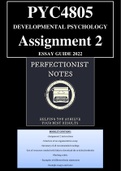Exam (elaborations)
PYC4805 Assignment 2 ESSAY GUIDE AND EXAMPLES 2022
- Institution
- University Of South Africa (Unisa)
NATURE VS NURTURE: Childhood and Adolescence. THIS DOCUMENT CONTAINS: Summaries of all the prescribed readings (articles and textbooks), 2 essay examples, examples of thesis statements and mind map for the essay, instructions, structure of an argumentative essay, rubric, etc. Active links to all r...
[Show more]



